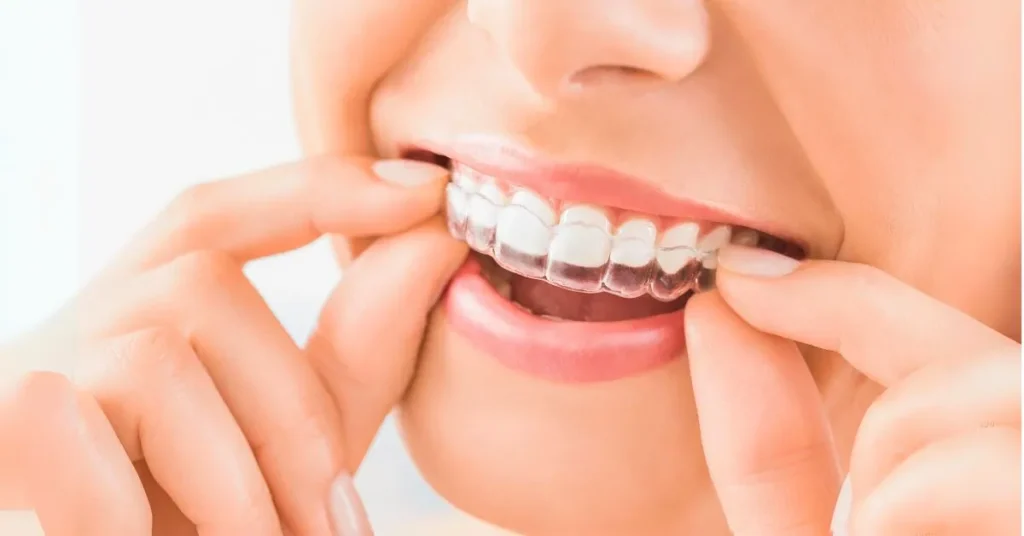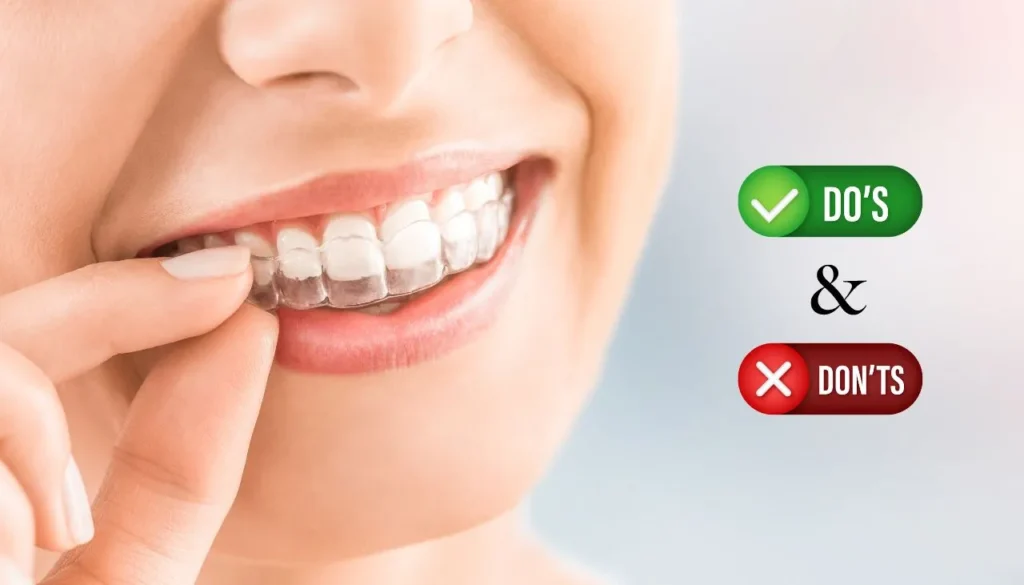The term braces comes with the visual of metal brackets and wires; however, Ceramic braces are made of ceramic brackets and frosted wires to match the shade of your natural teeth. As a result, these braces are less noticeable than metal braces, which consist of metal brackets and wires. Ceramic braces are meant for long-term effects but the treatment period might take a bit longer as these braces are not as strong as metal braces.
At the same time, clear aligners are clear plastic trays customized to fit your teeth for teeth retention purposes. Unlike braces, clear aligners are transparent thus invisible, and can be removed for eating and cleaning purposes, giving wearers ultimate comfort and aesthetic benefits.
Comparison table: Clear Aligners vs Ceramic Braces
| Factors | Clear Aligners | Ceramic Braces |
| Material | Elastic thermoplastic | Ceramic |
| Appearance | transparent | Tooth matching |
| Removability | Yes | No |
| Usage & Cleaning | easy | moderate |
| Free to eat | Yes | No |
| Cost | 45,000-2,00,000 | 35,000-1,00,000 |
| Treatment Period | 9-18 months | 18-36 months |
| Suitability | Suitable for mild to moderate cases | Suitable in mild, moderate and complexes cases |
The difference between Clear Aligners and Ceramic Braces
Cost Comparison:
Ceramic braces: Ceramic braces treatment costs between INR 40,000 and INR 1,00,000, depending on orthodontic concerns.
Clear Aligners: On average, clear aligners range from INR 35,000 to INR 2,00,000, depending on the type and complexity of dental issues.
Treatment Duration:
Ceramic Braces: The treatment period involves ceramic braces ranging between 18-36 months or more, depending upon the complexity.
Clear Aligners: The treatment period typically depends on orthodontic issues, but it will take between 9 and 18 months to cure the dental flaws with clear aligners.
Effectiveness:
Clear Aligners: Clear aligners can effectively treat less crooked teeth, gapped teeth, crowded mouth and misaligned bites but are not suitable for conditions like extremely crooked teeth, cross-bites, and malocclusions.
Ceramic Braces: however clear braces are not as strong as metal braces yet they can work wonders for extensive and severe cases like malocclusions and misalignment.
Comfort and Convenience:
Clear aligners: These plastic dental trays just fit onto your tooth where no extra attachments or wires are involved. So, this is a more comfortable and convenient option than any braces.
Ceramic Braces: Ceramic braces are more comfortable than metal braces. Instead of metal brackets, tooth-coloured ceramic brackets prevent the cheek or tongue from hurting. However, in some cases, the elastic wires can cause some discomfort inside the mouth, unlike clear aligners which do not come with any attachments.
Aesthetic that Impacts Lifestyle:
Clear Aligners: They are transparent and do not attract any unnecessary attention to your mouth or teeth while talking, giving a speech, or doing any activity, giving you the freedom to live your usual life hassle-free.
Ceramic Braces: Ceramic braces are less visible than metal braces, but the wires and elastics are still visible and sometimes may restrict speech.
Removability:
Clear Aligners: Clear aligners are loved by users mostly because they are removable for eating, cleaning, or other special occasions. However, it is recommended that you need to wear aligners for 22 or more hours daily for the best results.
Ceramic Braces: Once the ceramic braces are fixed to your teeth with the attachments, you will need to visit your dentist every four weeks to adjust the brackets. These braces can not be removed without involving a professional.
Diet Restrictions:
Clear Aligners: During the treatment process involving clear aligners, you do not have any food restrictions in particular as they are removable devices, so you can enjoy your meal after removing your aligner tray. On a precautionary basis, it is advised to avoid very hard or crunchy food, smoking or chewing tobacco, etc. These may harm the teeth alignment process.
Ceramic Braces: Certain diet restrictions are imposed during the teeth straightening process with ceramic braces. You should ensure that food particles do not stick to the braces while eating or snacking. In general, hard food (like corn from the comb, raw fruit, etc.), sticky, chewy, stringy food or drinks should be avoided with ceramic braces.
Maintenance & Aftercare:
Clear Aligners: It’s super easy to clean clear aligners. Just rinse them with water and brush them with a mild soap, and you are good to go. Keeping the aligners inside their prescribed case while not in use is recommended.
Ceramic Braces: These braces are adjusted by the orthodontists only at the time of the periodic checkups. It gives a limited scope of cleansing your teeth, and with the braces on, it may cause gum infection.
Pros and Cons:
Clear aligners:
| Pros | Cons |
| 1. Easy to use and comfortable 2. Virtually invisible, enhancing aesthetics 3. No diet restrictions 4. Lightweight 5. No metal 6. Removable | 1. Not recommended for complex cases 2. Generally more expensive 3. May have a longer treatment duration (6 to 18 months) |
Metal braces:
| Pros | Cons |
| 1. Lightweight 2. Lesser hassles than metal braces 3. Suitable for complex cases | 1. Can’t be removed 2. Not totally transparent 3. Diet restrictions |
Choosing Between Clear Aligners and Ceramic Braces
Both clear braces and aligners are advanced orthodontic treatments involved in the teeth straightening process.
Both types of treatments are helpful in conditions like crooked, crowded, gapped and overlapped teeth. Clear ceramic braces are discreet and less noticeable than metal braces, which are more commonly recommended for easy usage by younger adults and teens.
Again, clear aligners are transparent and popular with younger adults. Ceramic braces and aligners are part of aesthetic orthodontics, and both of these treatments have pros and cons, so you should consult an orthodontist to find out which option is best suited to your dental requirements.
FAQs
Yes, clear aligners are totally safe to use when prescribed by a professional orthodontist.
If your teen’s teeth are extremely crooked or they have a bad crossbite, overbite, or underbite, traditional braces will probably be the more effective option than clear aligners. In moderate cases, aligners work fine. In the case of teenagers, they should resist removing their aligners more often to attain fast results.
Ceramic braces are far more comfortable than their metal counterparts, though in some cases, they can irritate your gums or the sides of your mouth due to the materials used.
References
(2019 Dec). Orthodontic Treatment with Clear Aligners and The Scientific Reality Behind Their Marketing: A Literature Review.
Melkos AB. Advances in digital technology and orthodontics: a reference to the Invisalign method. Med Sci Monit. 2005;11:39–42. [PubMed] [Google Scholar]
Drake C, McGorray S, Dolce C, Nair M, Wheeler T. Orthodontic Tooth Movement with Clear Aligners. ISRN Dent. 2012 doi: 10.5402/2012/657973. doi: 10.5402/2012/657973. [PMC free article] [PubMed] [CrossRef] [CrossRef] [Google Scholar]
(November 2023) Journal Of Advanced Zoology 44(2):3342:3357

